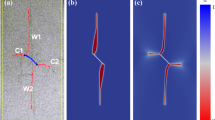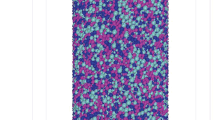Abstract
The article contains an analysis of the kinetics of brittle fracture processes during compression of a two-scale porous medium, in which a larger scale is associated with a system of holes. This work is a continuation of studies of fracture structures during compression. Within the framework of the project, experiments were carried out on samples of porous brittle model material (gypsum) containing a number of holes of different orientations with respect to the compression axis. They showed that fracture in the vicinity of holes in such materials under compression can develop both by initiating normal fracture cracks and by localizing compaction. In a model situation with a system of holes, the choice of the mechanism for the formation of local foci of destruction depends on the orientation of the system of holes relative to the compression axis. To interpret the experimental results, the stress state of the loaded system was calculated. A brief overview of the effects of local compaction under compression is given.
Similar content being viewed by others
REFERENCES
R. V. Goldstein and N. M. Osipenko, “Model of Brittle Fracture of Porous Materials in Compression,” Mat. Modelirovanie Sist. Prots., No. 17, 47–57 (2009).
R. V. Goldstein and N. M. Osipenko, “Some Models and Effects of Fracture under Compression,” in Actual Problems of Mechanics: 50 Years of the Ishlinsky Institute for Problems in Mechanics RAS, Ed. by F. L. Chernous’ko (Nauka, Moscow, 2015), pp. 338–356 [in Russian].
R. V. Goldstein and N. M. Osipenko, “Fracture Structures under High-Rate Compression,” in Problems of Solid and Rock Mechanics (Fizmatlit, Moscow, 2006), pp. 152–166 [in Russian].
R.V. Goldstein and N.M. Osipenko, “Influence of the Form of Material Structure Elements on the Fracture Scenario in a Complex Stress State,” Mech. Solids 50 (2), 147–159 (2015).
R.V. Goldstein and N.M. Osipenko, “Structures in Fracture Processes,” Mech. Solids 34 (5), 39–57 (1999).
B. Haimson and A. Klaetsch, “Compaction bands and the formation of slot-shaped breakouts in St. Peter sandstone,” Geologic. Soc. London Spec.Publ. 284 (1), 89–105 (2007).
B. Haimson and H. Lee, “Borehole breakouts and compaction bands in two high-porosity sandstones,” Int. J. Rock. Mech. Min. Sci. 41, 287–301 (2004).
H. Wu, N. Guo1, and J. Zhao, “Multiscale modeling and analysis of compaction bands in highporosity sandstones,” Acta Geotechn. 13, 575–599 (2018).
J. Fortn, S. Stanchits, G. Dresen, and Y. Gueguen, “Acoustic emission and velocities associated with the formation of compaction bands in sandstone,” J. Geophys. Res. 111 (10), B10203 (2006).
P. N. Mollema and M. A. Antonellini, “Compaction bands: A structural analog for anti-mode I cracks in Eolian sandstone,” Tectonophysics 267, 209–228 (1996).
S. Tembe, V. Vaidova, T.- F. Wong, and W Zhu, “Initiation and propagation of strain localization in circumferentially notched samples of two porous sandstone,” J. Geophys. Res. 111 (2), B02409 (2006).
D. A. Lockner, et al. “Quasi-static fault growth and shear fracture energy in granite,” Nature 350 (6313), 39–42 (1991).
J. W. Rudnicki and K. R. Sternlof, “Energy release model of compaction band propagation,” Geophys. Res. Lett. 32, L16303 (2005).
J. W. Rudnicki, “Models for compaction band propagation,” Geologic. Soc. London Spec. Publ. 284, 107–125 (2007).
G. Shahin, F. Marinelli, and G. Buscarnera, “Viscoplastic interpretation of localized compaction creep in porous rock,” J. Geophys. Res.: Solid Earth 124 (10), 9977–10648 (2019).
B. C. Haimson, “Borehole breakouts in Berea sandstone reveal a new fracture,” Pure Appl. Geophys. 160, 813–831 (2003).
V. V. Mokryakov, “Numerical simulation of functionally graded plane elastic medium by finite superelement method,” AIP Conf. Proc. 1922, 030004. 1–10 (2018).
L. N. Germanovich, R. L. Salganik, A. V. Dyskin, and K. K. Lee, “Mechanisms of brittle fracture of rock with multiple pre-existing cracks in compression,” Pure Appl. Geophys. 143 (13), 117–149 (1994).
Author information
Authors and Affiliations
Corresponding author
Additional information
Translated by M. K. Katuev
About this article
Cite this article
Mokryakov, V.V., Osipenko, N.M. Modeling of Ordered Fracture of a Two-Scale Porous Medium During Compression. Mech. Solids 55, 552–560 (2020). https://doi.org/10.3103/S002565442004010X
Received:
Revised:
Accepted:
Published:
Issue Date:
DOI: https://doi.org/10.3103/S002565442004010X




